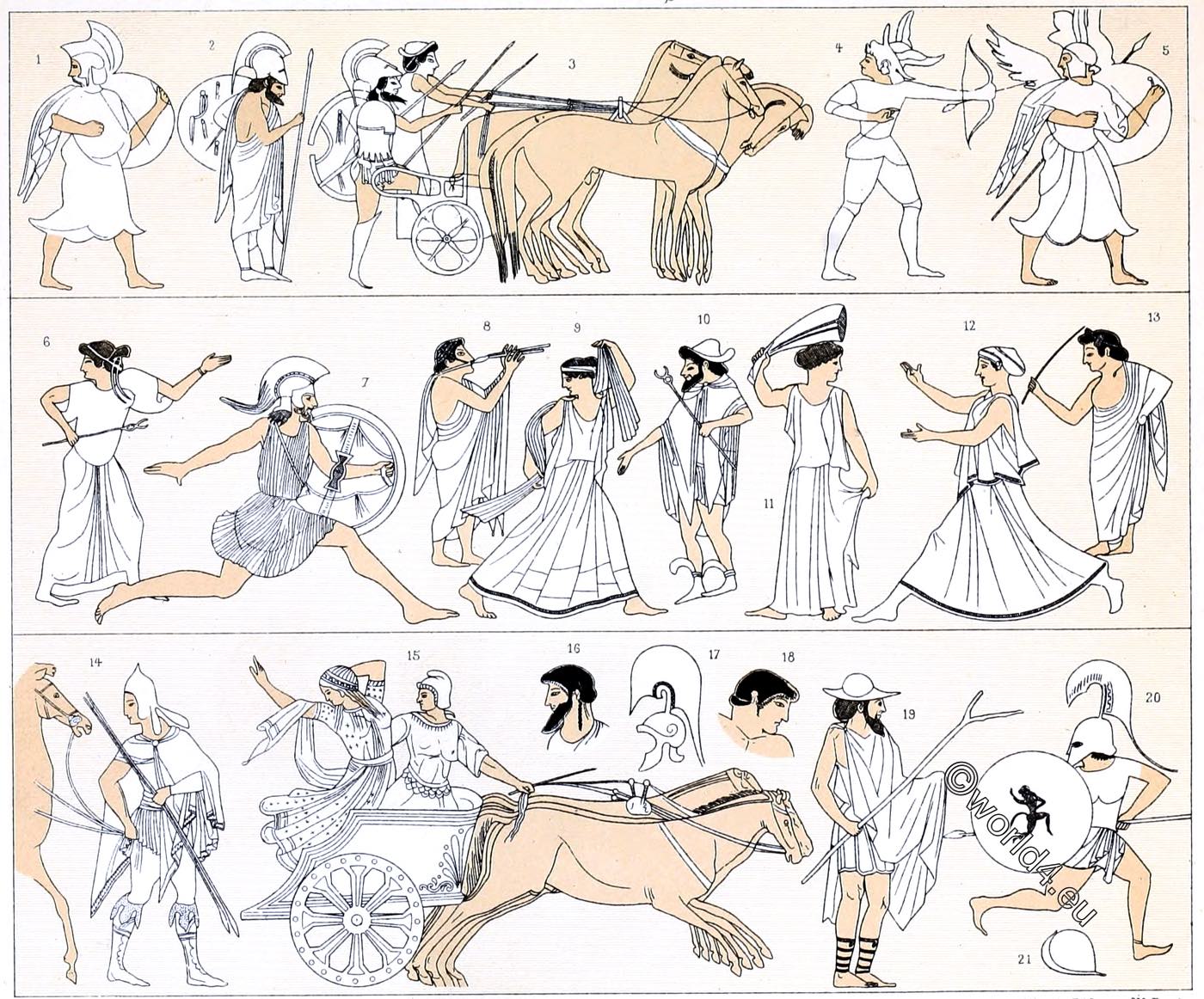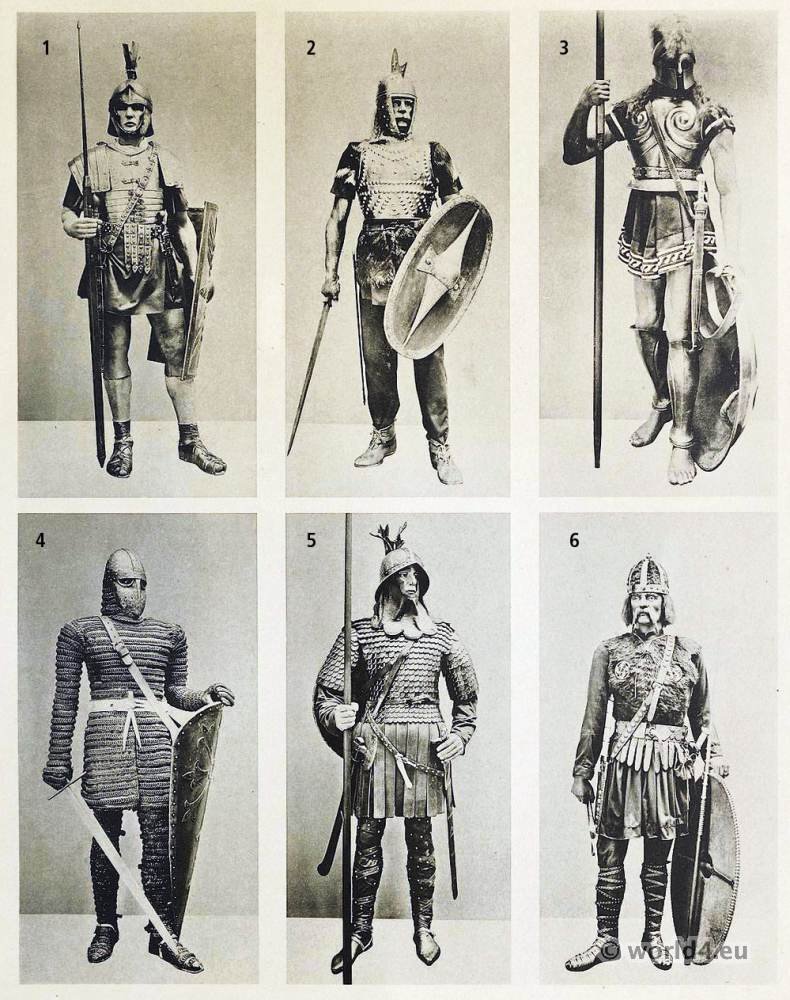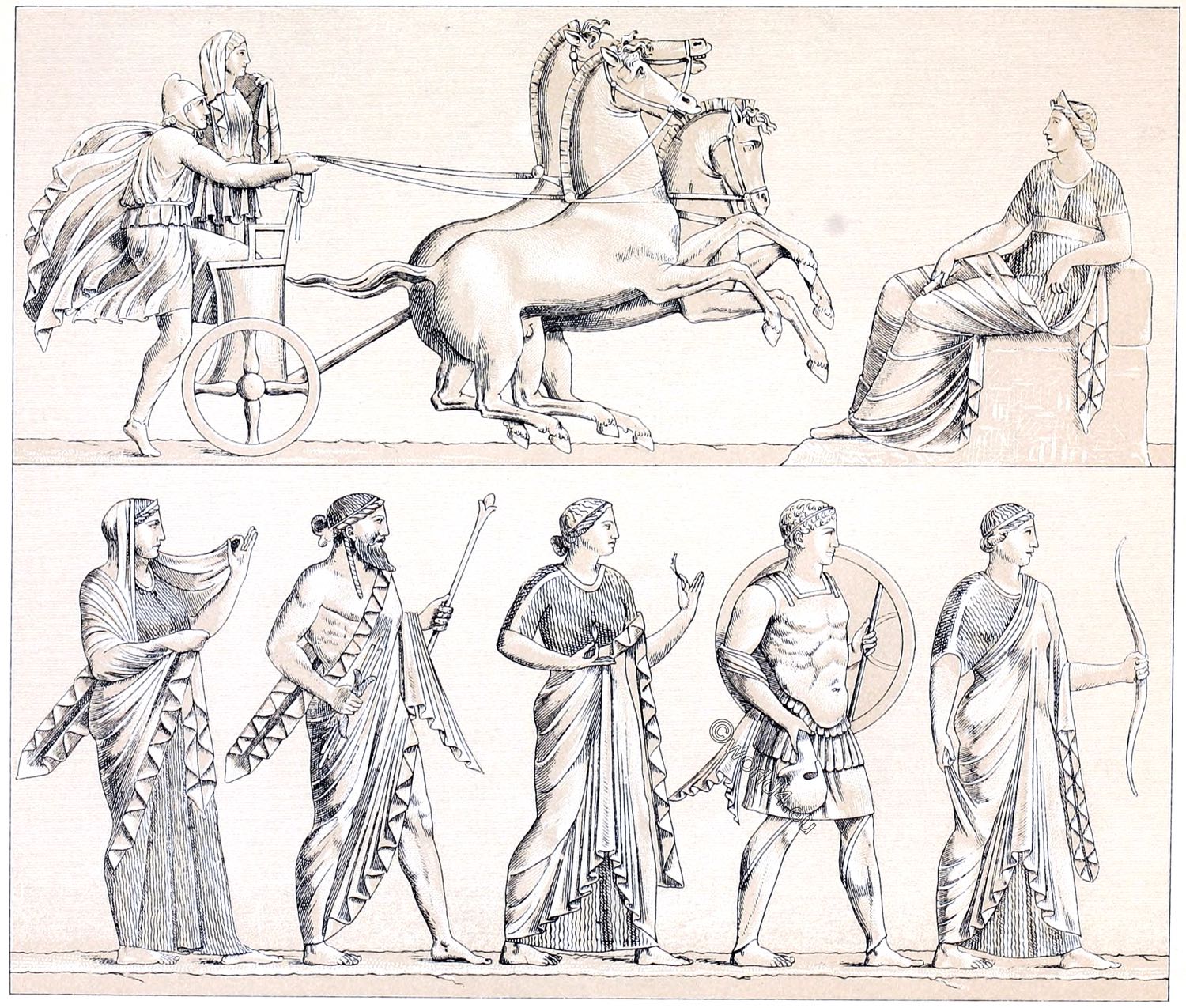
ETRURIA. WAR AND OTHER COSTUMES. CARRIAGE.
The Etruscans
by Auguste Racinet.
- Nos. 1 and 5. Amazons, withdrawing from battle. They wear pleated and daintily curved tunics with long, falling sleeves. One of them has a helmet with feathers, the other one a helmet with a double comb on.
- No. 4 Perseus with the winged helmet of Hades, which had the property of making the wearer invisible, armed with a bow.
- Nos. 2 and 3. Achilles and Patroclus, climbing on the war chariot of the former, led by Automedon. This painting joins the story of the Illiad. The chariot is covered with three horses (triga for the Romans).
- No. 6. Iris, messenger of the gods. – She carries the Caduceus (herald’s staff) as a sign of her mission.
- Nos. 7, 9, 1.1 and 12: Menelaus, following Helena, and two young girls as her companions. – The costumes of these figures are Greek, the style of the paintings, which come from vases, Etruscan.
- No. 8. Musician, blowing the double flute. – The Etruscans had brought this instrument, as well as the bronze trumpet, supposedly from Lydia to Italy.
- No. 10. Mercury. The god is depicted bearded. He wears a belted tunic and above it a pallium, which is arranged in such a way that it does not prevent him from walking. His feet are dressed in boots. The hat has a different shape than the Petasos of Thessaly.
- No. 13. Gymnasiarch involved in a wrestling match.
- No. 14. Warrior with a lace helmet, like the Thracians wore. His feet are dressed in lace-up boots, which were worn in war and hunting.
- No. 15. Quadriga. – The man in the Phrygian cap kidnaps a young girl on his quadriga. The eight-spoke wheel with a nailed tyre appears in the same form on the sculptures of Nineveh.
- No. 16 and 18. Male hairstyles.
- No. 17. Helm with high bush and comb.
- Number 19. Man in tunic and pallium. He wears the petasos on his head and his feet are tied with ribbons. He holds a stick in his hand that ends in a fork.
- No. 20. Etruscan warrior. – His helmet with high crest is the so-called Boeotian.
- No. 21. Helmet or cap.
(Based on the work of A. Noël des Vergas, L’ Étrurie et les Étrusques, Paris 1862-1864)

Interior view of the Tomb of the Reliefs in the Banditaccia necropolis near Cerveteri, Italy. End of the 4th century BC. Vue Interiéure de la Tombe dei Rilievi a Cervétri. 
Pilasters of the Tomb of the Rilievi at Cerveteri. Pilstres de la Tombe dei Rilievi a Cervétri. 
Painted Plates of Cerventri. Louvre Museum. Plaques Peintes de Cerventri. Musée du Louvre.
The Etruscans were an ancient people in Etruria, who lived in northern central Italy in the area of today’s regions of Tuscany, Umbria and Lazio and called themselves Rasenna according to Dionysios of Halicarnassus.
The Etruscan culture can be traced in this area between 800 B.C. and the second half of the 1st century B.C. After the Roman conquest (300 to 90 BC), the Etruscans were largely absorbed into the culture of the Roman Empire. But Prokop still reports about Etruscans among his contemporaries in the 6th century AD.
THE ETRUSCANS
by Carl Köhler
The oldest Etruscan type of dress had points of resemblance to that of the Greeks, both European and Asiatic.
Like the Greeks, the Etruscans wore a cloak, the tebenna, a kind of plaid, sometimes rectangular and sometimes shaped like a segment of a circle. One end was brought forward over the left shoulder, and the plaid itself was carried round the back and drawn through under the right arm, the other end being flung back over the left shoulder. The segment- shaped cloak was all along the characteristic Etruscan type—it was the real tebenna. Even before they came into touch with the Romans at all the Etruscans wore a shirt-like under-garment similar to the Greek chiton.
The dress of Etruscan women was somewhat Oriental in character. It was a long, shirt-like robe, as tight-fitting as possible over the shoulders, and increasing in width down to the foot. It had half- length sleeves, and was worn without a girdle. Made of the finest materials, and trimmed with beautiful braid, this robe reached to the feet, and sometimes even trailed on the ground. As it was almost always tight at the neck, sometimes covering it right up to the chin, it had a slit at the back, about 20 centimetres long, fastened with ribbons or other fasteners.
Over this robe Etruscan women wore a cloak, which was usually in shape a long rectangle. These cloaks, which were also made of fine material, were either simply hung over the back or passed over the head so as to cover almost the whole person.
Sometimes they were worn like a shawl over the shoulders, the ends being variously arranged in front, or crossed and fastened at the back.
Source:
- History of the costume in chronological development by Auguste Racinet. Edited by Adolf Rosenberg. Berlin 1888.
- A history of costume by Carl Kohler. Edited and augmented by Emma von Sichart. New York, G. H. Watt 1930.
- L’art étrusque by Jules Martha. Paris: Firmin-Didot, 1889.
Related
Discover more from World4 Costume Culture History
Subscribe to get the latest posts sent to your email.











